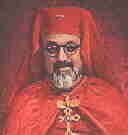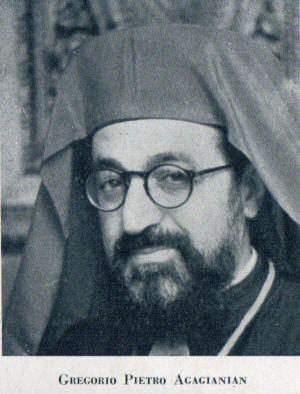Appointed 13 December 1937 Ordination December 23, 1917 | Term ended 25 August 1962 Consecration July 21, 1935 | |
 | ||
Other posts Cardinal-Bishop of Albano Rank Cardinal-Priest (1946-1970)Cardinal-Bishop (1970-1971) Name Gregoire-Pierre Agagianian Predecessor Avedis Bedros XIV. Arpiarian | ||
Gregorio Pietro XV Agagianian (anglicized: Gregory Peter; French: Grégoire-Pierre; Western Armenian: Գրիգոր Պետրոս ԺԵ. Աղաճանեան, Krikor Bedros XV Aghajanian; 18 September 1895 – 16 May 1971) was an Armenian Catholic Cardinal. He was the head of the Armenian Catholic Church (as Armenian Catholic Patriarch of Cilicia) from 1937 to 1962.
Contents
- Early life and priesthood
- Armenian Catholic Patriarch
- Cardinal
- Papabile
- 1958 conclave
- 1963 conclave
- Views
- Second Vatican Council
- On the Soviet Union
- Death
- Recognition
- Honors and awards
- References

Agagianian was elevated to the cardinalate in 1946 by Pope Pius XII. Aghajanian was Prefect of the Congregation for the Propagation of the Faith in the Roman Curia from 1958 to 1970. A scholar, linguist and an authority on the Soviet Union, Agagianian was twice considered papabile, during the conclaves of 1958 and 1963.
Early life and priesthood
Ghazaros Aghajanian (classical Armenian: Ղազարոս Աղաճանեան) was born in Akhaltsikhe, in present-day Georgia, then part of the Russian Empire. Around 60% of city's 15,000 inhabitants were Armenians at the time. His family was part of the Catholic minority of Javakhk Armenians. His ancestors came from Erzurum in the aftermath of a Russo-Turkish War. Fleeing Ottoman persecution, they sought refuge in the Russian Caucasus. He lost his father at an early age.
He attended the Russian-language Tiflis Seminary and then the Pontifical Urban University in Rome. He was ordained priest in Rome on December 23, 1917. Despite the upheaval bought by the Russian Revolution, he thereafter served as a parish priest in Tiflis (Tbilisi) until 1921 when Georgia was invaded by the Red Army. He left for Rome and did not see his family members until 1962, when, "at the personal intervention of Soviet leader Nikita Khrushchev, his sister Elisaveta was allowed to travel to see him in Rome." "When the Iron Curtain fell on the Caucasian Russia, his mother, Isguhi Barakgian, was shut in." He only knew that she was still alive in 1953.
In 1921, Agagianian became a faculty member and vice-rector of the Pontifical Armenian College (Pontificio Collegio Armeno) in Rome. He later served as rector of the college from 1932 to 1937. He was also a faculty member of the Pontifical Urban University from 1922 to 1932.
Armenian Catholic Patriarch
Agagianian was appointed titular bishop of Comana di Armenia on July 11, 1935 and was ordained bishop on 21 July 1935 at the San Nicola da Tolentino Church in Rome. His episcopal motto was Iustitia et Pax ("Justice and Peace").
Agagianian was elected Patriarch of Cilicia by the synod of Armenian Catholic bishops on November 30, 1937. He thus became the head of the Armenian Catholic Church. The election received papal conformation on December 13, 1937. He took the name Gregory Peter (French: Grégoire-Pierre XV, Armenian: Krikor-Bedros XV). He became the 15th patriarch of the world's 100,000 Armenian Catholics.
According to Rouben Paul Adalian, following the sizable losses in the Armenian Genocide, the Armenian Catholic Church regained its stature in the Armenian diaspora under the "astute management" of Agagianian. He resigned the pastoral governance of the Armenian patriarchate on August 25, 1962 to focus on his duties at Rome.
Cardinal
Agagianan was made Cardinal on February 18, 1946 by Pope Pius XII. He was appointed Cardinal-Priest of San Bartolomeo all'Isola on February 22, 1946.
Agagianian was appointed Pro-Prefect of the Sacred Congregation for the Propagation of the Faith (now called the Congregation for the Evangelization of Peoples) on June 18, 1958 and Prefect on July 18, 1960. As such he supervised the training of Catholic missionaries all over the world. According to Lentz, Agagianian was "largely responsible for liberalizing the church's policies in developing nations." He traveled extensively to the missionary areas for which he was responsible. He served in that position for more than a decade, until October 19, 1970.
On October 22, 1970 he was appointed Cardinal-Bishop with title to the Suburbicarian Diocese of Albano.
Papabile
Agagianian participated in the papal conclaves of 1958 and 1963, during which his name was discussed as a papal candidate (i.e. papabile). According to J. Peter Pham, Agagianian was considered a "serious (albeit unwilling) candidate" for the papacy in both conclaves. Agagianian was the "first non-Italian in centuries to be considered a serious candidate for the papacy." The New York Times wrote upon his death that "Twice in the last 13 years, Cardinal Agagianian was considered the leading candidate for the Papacy if a non-Italian were to be elected to the highest post in the Roman Catholic Church."
Armenian historian Ara Sanjian wrote in 1995 that Agagianian's name was "discussed seriously as a possible candidate in the papal elections" of 1958 and 1963 and added that these "persistent rumours" cannot be confirmed officially because of Catholic traditions of absolute secrecy on matters relating to papal elections.
1958 conclave
According to Greg Tobin and Robert J. Wister, Agagianian was one of the favorites in the 1958 conclave, "known to be close" to Pope Pius XII. His candidacy was widely discussed. Even before the death of Pope Pius XII, The Milwaukee Sentinel wrote that "Some of the most authoritative voices of Vatican affairs believe today that [...] Agagianian [...] is now without question the leading candidate to succeed Pope Pius XII." On October 9, the day Pope Pius died, The Milwaukee Sentinel wrote that he is "considered by very responsible Vatican circles as the foremost choice" to succeed Pope Pius. He was also popular amongst believers. Chicago Tribune wrote on October 25, 1958: "Cheering Roman crowds 'picked' the next pope [...] He is silver bearded Cardinal Agagianian, the Armenian patriarch [...] The crowds shouted 'Long live the new pope' when Agagianian drove to a meeting with the 51 other cardinals." The newspaper added, "Despite the crowds' cheers for Agagianian, the cardinals are expected to try first to agree on an Italian cardinal."
The election was seen as a struggle between Italian Angelo Roncalli (who was eventually elected and became Pope John XXIII) and non-Italian Agagianian. Agagianian reportedly came in second. Three months after the conclave, Roncalli revealed that his name and that of Agagianian "went up and down like two chickpeas in boiling water" during the conclave. Armenian-American journalist Tom Vartabedian suggests that it is possible that Agagianian might have been elected but declined the post.
1963 conclave
According to John Whooley, "On the death of John XXIII, there was much expectation that Agagianian would be elected in his stead." In the 1963 conclave Agagianian was considered "a strong contender, most 'papabile', and his figure well-known, even beyond the Catholic world." According to the Armenian Catholic Church website, Agagianian was rumored to have been actually elected at this conclave but declined to accept.
According to speculations by Italian journalists Andrea Tornielli (1993) and Giovanni Bensi (2013) Italian intelligence services were involved in preventing Agagianian from being elected pope in 1963. They maintain that SIFAR (Servizio informazioni forze armate) mounted a smear campaign against Agagianian prior to the conclave by "circulating a report that his 70-year old sister, Elizabeta Papikova, had ties to the KGB, the Soviet security service, and had made contact with the Soviet embassy during her visit to Rome in 1962 to meet her brother."
Views
Thomas Rausch described him as "hardly a strict traditionalist." According to Ralph M. Wiltgen, he was "regarded by the liberals as the most acceptable of the Curial cardinals" in the Second Vatican Council. In 1963 Life magazine called him "liberal" and "cosmopolitan" and "a moderate who has traveled widely in his capacity as head of all the Church's missionary activity." He was described as the Catholic Church's "topmost champion of the unity of the Christian churches under the Pope of Rome as leader of 'the' church."
Second Vatican Council
Agagianian attended the Second Vatican Council, which took place from 1962 to 1965, and sat on its Board of Presidency. He had a special role in the preparation of the Constitutions of the Catholic Church in the modern world: Ad gentes and Gaudium et spes. He was appointed by Pope Paul VI as one of the four moderators to help the Council become more efficient," along with Leo Joseph Suenens (Belgium), Julius Döpfner (Germany), Giacomo Lercaro (Italy). They had the task of "steering the debates." Agagianian was the only one of these four from the Curia, and represented the Eastern Catholic Churches.
On the Soviet Union
During his lifetime Agagianian was considered the Catholic Church's leading expert on communism and the Soviet Union. In January 1958 UK Ambassador to the Holy See Marcus Cheke wrote a diplomatic report addressed to Edward Michael Rose, the Head of the Levant Department at the British Foreign Office, in which Cheke describes a meeting he had with Cardinal Agagianian. Cheke wrote that "On the whole, I got the impression that the Cardinal, like certain members of the Vatican Secretariat of State, believes that the best thing for the Western powers to do is to hang on, avoid war (and the more strongly armed and united they are, the less danger there is of Russia venturing on a war) and to wait for a transformation inside Russia, which he thinks will happen sooner or later."
He was quoted in 1958 as saying: "The time is to come when religion will be honored once again in Russian lands. Bolshevism [he stressed Bolshevism, not the Socialist revolution of October, 1917] and the religious feelings of the Soviet peoples will emerge to the light of the sun. This is because the first victims of the Bolshevist regime today are the Soviet peoples themselves."
Death
Agagianian died of cancer in Rome on May 16, 1971. He was buried in Rome's San Nicola da Tolentino Armenian church. There are two portraits of Agagianian done by Armenian artist Ariel Agemian K.S.G. They can be viewed on the [1]
Recognition
Upon his death, The New York Times wrote that "Despite his failure to win election from the Sacred College of Cardinals, [Agagianian] nevertheless made a major impact on the development of the [Catholic] church and its role in the newly developing nations." Agagianian has been called "the most celebrated Armenian Catholic in history." He was the second Armenian Catholic churchman ever to be made cardinal, after Andon Bedros IX Hassoun in 1880.
Despite being Armenian, he was "Romanized" as he spent most of his adult life in Rome. He "spoke with a Roman accent." Agagianian was considered to have been bi-ritual as he used both the Armenian and Latin rites. Pope Pius XII, who had a "great interest in the Eastern churches," called on Agagianian to celebrate a pontifical Mass in the Armenian rite in the Sistine Chapel on March 12, 1946.
Agagianian was a polyglot and renowned linguist. He spoke fluent Armenian (his mother language), Russian, Italian, French, English, Latin and learned German, Spanish, classical Greek, Arabic. He also had "a working knowledge of the Slavic languages and [could] speak most of the languages of the Middle and Far East." He was described as the College of Cardinals' "top linguist" in 1953.
